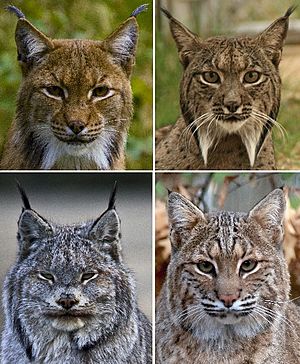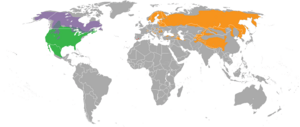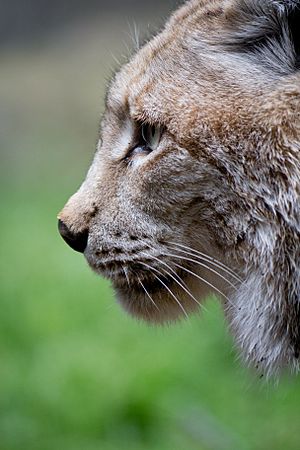Lynx facts for kids
Quick facts for kids Lynx |
|
|---|---|
 |
|
| The four types of lynx: Eurasian, Iberian, Bobcat, and Canada lynx. | |
| Scientific classification |
|
| Kingdom: | Animalia |
| Phylum: | Chordata |
| Class: | Mammalia |
| Order: | Carnivora |
| Suborder: | Feliformia |
| Family: | Felidae |
| Subfamily: | Felinae |
| Genus: | Lynx Kerr, 1792 |
| Type species | |
| Felis lynx Linnaeus, 1758
|
|
| Species | |
|
|
 |
|
| Lynx ranges: red = Iberian, purple = Canadian, green = Bobcat, orange = Eurasian | |
A lynx (plural: lynx or lynxes) is a type of medium-sized wild cat. There are four main species: the Canada lynx, Iberian lynx, Eurasian lynx, and bobcat. The word lynx comes from an old Greek word meaning 'light' or 'brightness'. This refers to how their eyes seem to glow in the dark.
Contents
What Lynx Look Like
Lynx have some special features. They have a short tail and black hair tufts on the tips of their ears. Their paws are large and padded, which helps them walk on snow. They also have long whiskers on their face. Under their neck, they have a ruff of fur that can look like a bow tie, but it's often hard to see.
Their fur color can be medium brown, gold, or beige-white. Sometimes they have dark brown spots, especially on their legs. All lynx species have white fur on their chests, bellies, and the inside of their legs.
The lynx's fur length, color, and paw size change depending on where they live. In warmer places like the Southwestern United States, they have shorter, darker fur and smaller paws. In colder, northern areas, their fur is thicker and lighter, and their paws are larger and more padded. This helps them adapt to snowy environments.
The smallest lynx species are the bobcat and the Canada lynx. The largest is the Eurasian lynx. However, there can be big differences in size even within the same species.
| Species | Sex | Weight | Length | Height (at shoulders) |
|---|---|---|---|---|
Eurasian lynx |
males | 18 to 30 kg (40 to 66 lb) | 81 to 129 cm (32 to 51 in) | 70 cm (28 in) |
| females | 18 kg (40 lb) | |||
Canada lynx |
Both | 8 to 14 kilograms (18 to 31 lb) | 90 cm (35 in) | 48 to 56 cm (19 to 22 in) |
Iberian lynx |
males | 12.9 kg (28 lb) | 85 to 110 cm (33 to 43 in) | 60 to 70 cm (24 to 28 in) |
| females | 9.4 kg (21 lb) | |||
Bobcat |
males | 7.3 to 14 kg (16 to 31 lb) | 71 to 100 cm (28 to 39 in) | 51 to 61 cm (20 to 24 in) |
| females | 9.1 kg (20 lb) |
Types of Lynx
Scientists believe the four living lynx species came from an older species called Lynx issiodorensis. This ancient lynx lived in Europe and Africa a very long time ago.
Eurasian Lynx
The Eurasian lynx (Lynx lynx) is the biggest of the four lynx species. It lives in forests across Europe, Central Asia, and Siberia. Even though it's not considered highly endangered, its numbers have dropped in many parts of Europe. Efforts are now being made to bring them back to these areas.
In summer, the Eurasian lynx has a short, reddish-brown coat. In winter, this changes to a thicker, silver-grey or greyish-brown coat. This lynx hunts by sneaking up on its prey and then jumping. It likes to hunt in rugged, forested areas. A favorite food for them is roe deer. However, they will eat any animal that is easy to catch, as they are opportunistic hunters.
Canada Lynx
The Canada lynx (Lynx canadensis) lives in North America. It can be found in forests and tundra regions across Canada and Alaska, and in some northern parts of the United States. In the past, they lived in many northern U.S. states. By 2010, after 11 years of work, they were successfully brought back to Colorado. In 2000, the U.S. government listed the Canada lynx as a threatened species in the lower 48 states.
The Canada lynx is good at climbing and swimming. It makes its dens under fallen trees or rock ledges. It has a thick coat and wide paws, which help it walk on snow much better than a bobcat. The Canada lynx mostly eats snowshoe hares. Its population depends a lot on how many snowshoe hares there are. If hare numbers are low, they will also hunt other medium-sized mammals and birds.
Iberian Lynx
The Iberian lynx (Lynx pardinus) is an endangered species that lives in the Iberian Peninsula in Southern Europe. It used to be the most endangered cat species in the world. However, thanks to conservation efforts, its status has improved from "critically endangered" to "endangered." If this species were to disappear, it would be the first cat extinction since the Smilodon (saber-toothed cat) 10,000 years ago.
The Iberian lynx was once thought to be a type of Eurasian lynx. But now, scientists consider it a separate species. Both species lived in central Europe during the Ice Age, but they preferred different habitats. The Iberian lynx is also believed to have evolved from Lynx issiodorensis.
Bobcat
The bobcat (Lynx rufus) is a wild cat found in North America. There are 13 different types of bobcats. They are common across southern Canada, the continental United States, and northern Mexico. Like the Eurasian lynx, the bobcat is not considered highly endangered.
The bobcat is a very adaptable hunter. It lives in many different places, including forests, swamps, deserts, mountains, and even farm areas. Unlike other lynx, it doesn't only live in deep forests. Its spotted fur helps it blend in with its surroundings. The number of bobcats depends mainly on how many prey animals are available. However, bobcats are sometimes hunted by larger predators like coyotes.
The bobcat looks similar to other lynx species, but it is usually the smallest. Its fur color varies, but it's generally tan to grayish-brown. It has black stripes on its body and dark bars on its front legs and tail. Its ears have black tips and short, black tufts. The fur on its lips, chin, and belly is usually off-white. Bobcats living in desert areas have the lightest fur, while those in northern forests have the darkest.
Behavior and Life Cycle
Lynx usually live alone, but sometimes a small group might travel and hunt together. Mating happens in late winter. Once a year, the female lynx gives birth to one to four kittens after about 70 days. The young stay with their mother for about nine months, through one winter. After that, they leave to live on their own as young adults. Lynx make their dens in rocky cracks or under ledges.
What Lynx Eat
Lynx eat many different animals. Their diet includes larger animals like white-tailed deer, reindeer, roe deer, and chamois. They also eat smaller, more common prey like snowshoe hares, fish, foxes, sheep, squirrels, mice, turkeys, and other birds. They also hunt ptarmigans, voles, and grouse. The Iberian lynx mostly eats rabbits and hares.
Where Lynx Live
Lynx prefer to live in high-altitude forests. These forests have lots of shrubs, reeds, and tall grass for cover. Even though lynx hunt on the ground, they can climb trees and swim well, sometimes catching fish.
Europe and Asia
The Eurasian lynx lives across central and northern Europe and Asia, reaching as far as northern Pakistan and India. In Iran, they can be found in the Mount Damavand area. In the early 1900s, the Eurasian lynx was thought to be gone from the wild in Slovenia and Croatia. However, a project started in 1973 successfully brought lynx back to these areas. In both countries, the lynx is now an endangered species and protected by law.
Several projects to bring lynx back to Switzerland started in the 1970s and have been successful. Since the 1990s, there have been many efforts to reintroduce the Eurasian lynx in Germany. A small group can now be found in the Harz mountains.
Lynx are also found in the Białowieża Forest in northeastern Poland, in Estonia, and in northern and western China, especially the Tibetan Plateau. In Romania, there are more than 2,000 lynx, which is the largest population in Europe outside of Russia.
Lynx are more common in northern Europe, especially in Norway, Sweden, Estonia, Finland, and northern Russia. Sweden has an estimated 1200–1500 lynx. Finland's lynx population was 1900–2100 in 2008 and has been growing since 1992. Lynx in Britain disappeared in the 1600s, but some people want to bring them back to help control deer numbers.
The endangered Iberian lynx lives in southern Spain and also in eastern Portugal. There is a special center for Iberian lynx reproduction near Silves in southern Portugal.
North America
The two lynx species in North America, the Canada lynx and bobcats, both live in the temperate zone. The bobcat is common across southern Canada, the United States, and northern Mexico. The Canada lynx mainly lives in the boreal forests of Canada and Alaska.
Conservation Efforts
The Iberian lynx is the most endangered cat in the world. There are only two groups of them left, totaling about 300 animals, in southern Spain. Hunting lynx is illegal in many countries to protect them.
National Animal
The lynx is an important animal in some countries. It is considered a national animal in the Republic of Macedonia. You can even see it on the back of the 5 denar coin. It is also the national animal of Romania.
Images for kids
-
A mother and cub, Kenai National Wildlife Refuge, Alaska
See also
 In Spanish: Lince para niños
In Spanish: Lince para niños









